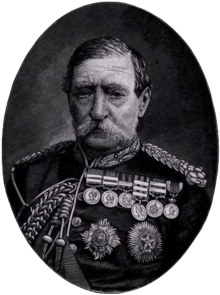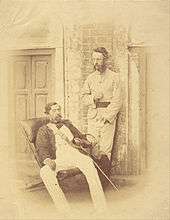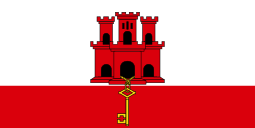Robert Napier, 1st Baron Napier of Magdala
| Field Marshal The Right Honourable The Lord Napier of Magdala GCB, GCSI, FRS | |
|---|---|
 | |
| Governor of Gibraltar | |
|
In office 23 June 1876 – 3 January 1883 | |
| Monarch | Victoria |
| Prime Minister |
Benjamin Disraeli William Ewart Gladstone |
| Preceded by | Sir William Williams |
| Succeeded by | Sir John Miller Adye |
| Acting Viceroy of India | |
|
In office 21 November 1863 – 2 December 1863 | |
| Monarch | Victoria |
| Prime Minister | The Viscount Palmerston |
| Preceded by | The Earl of Elgin |
| Succeeded by |
Sir William Denison As Acting Viceroy |
| Personal details | |
| Born |
6 December 1810 Ceylon |
| Died |
14 January 1890 (aged 79) London, England |
| Alma mater | Addiscombe Military Seminary |
| Military service | |
| Allegiance |
|
| Service/branch |
|
| Years of service | 1828–1890 |
| Rank | Field Marshal |
| Commands |
Bombay Army Commander-in-Chief, India |
| Battles/wars |
First Anglo-Sikh War Second Anglo-Sikh War Indian Mutiny Second Opium War Expedition to Abyssinia |
| Awards |
Knight Grand Cross of the Order of the Bath Knight Grand Commander of the Order of the Star of India |
Field Marshal Robert Cornelius Napier, 1st Baron Napier of Magdala GCB, GCSI, FRS (6 December 1810 – 14 January 1890) was an Indian Army officer. He fought in the First Anglo-Sikh War and the Second Anglo-Sikh War before seeing action as chief engineer during the second relief of Lucknow in March 1858 during the Indian Mutiny. He also served in the Second Opium War as commander of the 2nd division of the expeditionary force which took part in the Battle of Taku Forts in August 1860, the entry to Peking in September 1860 and the destruction of the Old Summer Palace in October 1860. He subsequently led the punitive expedition to Abyssinia July 1867, defeating the Emperor Tewodros II of Ethiopia with minimal loss of life among his own forces and rescuing the hostages of Tewodros.
Military career
Early career
Born the son of Major Charles Frederick Napier, who was wounded at the storming of Meester Cornelis (now Jatinegara) in Java on (26 August 1810) and died some months later, and Catherine Napier (née Carrington), Napier was educated at Addiscombe Military Seminary before being commissioned into the Bengal Engineers on 15 December 1826.[1] He attended the Royal Engineer Establishment at Chatham with the rank of ensign from 7 June 1827[2] before being promoted to lieutenant on 28 September 1827 and being sent to India in November 1828.[3] After commanding a company at Delhi, he was employed in the irrigation works of the Public Works Department until 1836 when he returned to England for leave on account of his poor health.[3] Promoted to captain on 25 January 1841, he was appointed garrison engineer at Sirhind in 1842.[3]
First Anglo-Sikh War
Napier served under Sir Hugh Gough during the First Anglo-Sikh War and commanded the Bengal Engineers at the Battle of Mudki in December 1845.[3] He was severely wounded at the Battle of Ferozeshah in December 1845 while storming the Sikh camp and was also present at the Battle of Sobraon in February 1846.[3] Promoted to brevet major on 3 April 1846,[4] he was chief engineer at the siege of the fortress of Kote Kangra in the Punjab by Brigadier-General Wheeler in May 1846.[3]
Second Anglo-Sikh War
Having been appointed as consulting engineer to the Punjab resident and to the Council of Regency of the Punjab, Napier was called to direct the siege of Multan in September 1848 at the outset of the Second Anglo-Sikh War.[3] He was wounded during the siege but managed to recover sufficiently to be present at the successful storming of Multan in January 1849 and at the surrender of the fortress of Chiniot shortly thereafter.[1] He took part in the Battle of Gujrat in February 1849 and accompanied Sir Walter Gilbert as he pursued the Sikhs and was at the surrender of the Sikh army.[1] He was promoted to brevet lieutenant-colonel on 7 June 1849[5] and became chief engineer to the Board of Administration of Punjab Province at the end of the War.[3]
North-West Frontier
In December 1852 Napier took command of a column in the first Hazara expedition,[lower-alpha 1] and in November 1853 against the Afridis on the North-West frontier.[1] He was promoted to the brevet rank of colonel on 28 November 1854 and the substantive rank of lieutenant colonel on 15 April 1856.[3]
Indian Mutiny

Napier was appointed military secretary and adjutant general to Sir James Outram, whose forces took part in the actions leading to the first relief of Lucknow in September 1857.[6] He remained as chief engineer until the second relief in November 1857, when he was badly wounded while crossing an exposed space with Outram and Sir Henry Havelock to meet with Sir Colin Campbell.[1] He recovered sufficiently to be present at the capture of Lucknow in March 1858.[6]
Napier then joined Sir Hugh Rose as second-in-command for the march on Gwalior and commanded the 2nd Brigade at the Battle of Morar in June 1858.[1] After Gwalior fell, Napier and his 700 men pursued, caught and defeated Tatya Tope's force of 12,000 men on the plains of Jaora Alipur.[1] After Sir Hugh Rose's departure, Napier assumed command of the Gwalior division and helped capture Paori in August 1858, routed Prince Ferozepore at Ranode in December 1858 and secured the surrender of Man Singh and Tatya Tope, ending the war, in January 1859.[1]
China

In January 1860 during the Second Opium War, Napier assumed command of the 2nd division of the expeditionary force under Sir James Hope Grant and took part in the Battle of Taku Forts in August 1860, the entry to Peking in September 1860 and the destruction of the Old Summer Palace in October 1860.[6] He was promoted to brevet major-general on 15 February 1861[7] and to the substantive rank of colonel on 18 February 1861.[8]
Napier became the military member of the Council of the Governor-General of India in 1861, acting for a short while as Governor-General after the sudden death of Lord Elgin.[1] He assumed command of the Bombay Army with the local rank of lieutenant general on 7 February 1865[9] and received promotion to the substantive rank of lieutenant-general on 1 March 1867[10] before taking command of the punitive expedition to Abyssinia July 1867.[6]
Abyssinia

Napier achieved his greatest fame as an army officer when he led the expedition of 1868 against Emperor Tewodros II of Ethiopia. The Ethiopian ruler was holding a number of Protestant missionaries hostage, in his mountain capital of Magdala, as well as two British diplomats who had attempted to negotiate their freedom (Tewodros had unwisely taken them hostage as well). After months of planning and other preparations, the advance guard of engineers landed at Zula on the Red Sea to construct a port on 30 October 1867; Napier himself arrived in Zula on 2 January 1868, and on 25 January 1868 led his troops south into the Ethiopian Highlands.[1]

The expedition involved crossing 400 miles (644 km) of mountainous terrain lacking roads or bridges occupied by local people with a known history of hostility towards outsiders. The expedition overcame the first obstacle, the terrain, by thorough logistical planning and engineering ability. Shrewd diplomacy dealt with the second obstacle, local opposition. On the one hand, Napier made it clear to the Ethiopians that the sole intent of the British force was to rescue the imprisoned Europeans—not conquest; on the other, Napier met with local potentates such as Ras Kassa (the future Emperor Yohannes IV) and arranged to purchase needed supplies with the 4.35 million Maria Theresa thalers (the preferred currency of the area) the British had purchased from the mint in Vienna. What helped Napier was the general disaffection with, if not hostility to, Tewodros, and a desire to replace him, held by several native leaders, as well as a general sense that his hostage-taking was bound to lead to trouble.[11]
Napier's troops reached the foot of Magdala on 9 April 1868, and the next day, Good Friday, he defeated the 9,000 troops still loyal to Tewodros at the Battle of Magdala for the loss of only 2 British lives. Although Emperor Tewodros surrendered his hostages and made repeated efforts for a negotiated surrender, the distrustful Napier pressed on and ordered an assault on the mountain redoubt on 13 April 1868. The British captured Magdala, and Emperor Tewodros killed himself, leaving a grandiose statement that he preferred to "fall into the hands of God, rather than man."[12] Napier then ordered the destruction of Tewodros' artillery and the burning of Magdala as retribution. This included the expedition and its troops looting many local artefacts, which they took back to Britain. The artifacts still reside in collections in the UK, despite representations by some for their return.[13]
After the Ethiopian campaign, Napier was made a Fellow of the Royal Society[14] and a Freeman of the City of London.[1] He was also elevated to the peerage as Baron Napier of Magdala on 11 July 1868[15] and granted an annuity for life.[16]
Later career
Napier became Commander-in-Chief, India with the local rank of full general in April 1870,[17] and having been promoted to the substantive rank of full general on 1 April 1874,[18] he became Governor of Gibraltar in June 1876.[19] In November 1879 he represented Queen Victoria at Madrid as ambassador extraordinary upon the occasion of Alfonso XII of Spain's second marriage and in December 1879 he became a member of the Royal Commission on the organization of the army.[1] Standing down as Governor of Gibraltar,[20] he was promoted to field marshal on 1 January 1883[21] and appointed to a Royal Commission in inquire into the condition of the Crofters and Cottars in the Highlands and Islands of Scotland in March 1883.[22]
Napier was also honorary colonel of the 3rd London Rifle Volunteer Corps[23] and colonel-commandant of the Royal Engineers.[24] He became Constable of the Tower of London in January 1887[25] but died of influenza at Eaton Square in London on 14 January 1890 and was buried in St Paul's Cathedral.[26]
Legacy

In 1883 the British government installed one Armstrong 100 ton gun in a battery in Gibraltar that they named the Napier of Magdala Battery[27] and in 1891 a statue of Napier on horseback by Sir Joseph Boehm was unveiled in front of Carlton House Gardens in London: it was moved to Kensington Square in 1920.[28]
The descendants of the Third City of London Rifle Volunteer Corps are located within Napier House Army Reserve Centre, Grove Park, London; the building is named in his honour.[29]
Honours
Napier's honours included:
- Knight Grand Cross of the Order of the Bath (GCB) – 27 April 1868[30] (KCB – 27 July 1858[31])
- Knight Grand Commander of the Order of the Star of India (GCSI) – 16 September 1867[32]
Family
In June 1840 Napier married Anne Pearse; they had three sons and three daughters before his wife died in childbirth in 1849.[3] In April 1861 he married Maria Cecilia Smythe Scott: they had six sons and three daughters.[6]
Notes
- ↑ Also see Muhammad Habib Khan Tarin
References
- 1 2 3 4 5 6 7 8 9 10 11 12 "Napier, Robert Cornelis, first Baron Napier of Magdala". Oxford Dictionary of National Biography. Retrieved 24 November 2013.
- ↑ The London Gazette: no. 18373. p. 1371. 26 June 1827. Retrieved 24 November 2013.
- 1 2 3 4 5 6 7 8 9 10 Heathcote, p. 233
- ↑ The London Gazette: no. 20591. p. 1236. 3 April 1846. Retrieved 24 November 2013.
- ↑ The London Gazette: no. 20986. p. 1865. 7 June 1849. Retrieved 24 November 2013.
- 1 2 3 4 5 Heathcote, p. 224
- ↑ The London Gazette: no. 22480. p. 655. 15 February 1861. Retrieved 24 November 2013.
- ↑ The London Gazette: no. 22621. p. 2238. 29 April 1862. Retrieved 24 November 2013.
- ↑ The London Gazette: no. 22937. p. 591. 7 February 1865. Retrieved 24 November 2013.
- ↑ The London Gazette: no. 23250. p. 2759. 14 May 1867. Retrieved 24 November 2013.
- ↑ Rubenson, pp. 256–263. The total number of Thalers is from Pankhurst 1968, p. 469
- ↑ Rubenson, p. 268
- ↑ Eshete, Andreas; Pankhurst, Richard. "Memorandum on the Loot from Magdala (Ethiopia) addressed to the Culture, Media and Sport Committee of the United Kingdom Parliament, by the Association for the Return of the Ethiopian Magdala Treasures". Retrieved 24 November 2013.
- ↑ "Fellowship of Royal Society". The Royal Society. Retrieved 24 November 2013.
- ↑ The London Gazette: no. 23400. p. 3937. 14 July 1868. Retrieved 24 November 2013.
- ↑ The London Gazette: no. 23409. p. 4325. 4 August 1868. Retrieved 24 November 2013.
- ↑ The London Gazette: no. 23585. p. 755. 8 February 1870. Retrieved 24 November 2013.
- ↑ The London Gazette: no. 24082. p. 1924. 31 March 1874. Retrieved 24 November 2013.
- ↑ The London Gazette: no. 24342. p. 3820. 4 July 1876. Retrieved 24 November 2013.
- ↑ The London Gazette: no. 25175. p. 6250. 8 December 1882. Retrieved 24 November 2013.
- ↑ The London Gazette: no. 25183. p. 6650. 29 December 1882. Retrieved 24 November 2013.
- ↑ The London Gazette: no. 25215. p. 1633. 23 March 1883. Retrieved 24 November 2013.
- ↑ The London Gazette: no. 23403. p. 4118. 24 July 1868. Retrieved 24 November 2013.
- ↑ The London Gazette: no. 24082. p. 1923. 31 March 1874. Retrieved 24 November 2013.
- ↑ The London Gazette: no. 25662. p. 100. 7 January 1887. Retrieved 24 November 2013.
- ↑ Heathcote, p. 225
- ↑ Fa, p.64
- ↑ "Statue of Robert Cornelis Napier, Baron Napier of Magdala". Pastscape. Retrieved 24 November 2013.
- ↑ Digby, Planck (1946). The Shiny Seventh: History of the 7th (City of London) Battalion London Regiment. ISBN 1-84342-366-9.
- ↑ The London Gazette: no. 23374. p. 2431. 28 April 1868. Retrieved 24 November 2013.
- ↑ The London Gazette: no. 22166. p. 3475. 27 July 1858. Retrieved 24 November 2013.
- ↑ The London Gazette: no. 23302. p. 5109. 17 September 1867. Retrieved 24 November 2013.
Secondary sources
- Fa, Darren; et al. (2006). The Fortifications of Gibraltar 1068–1945. Gibraltar Museum. ISBN 9781846030161.
- Heathcote, Tony (1999). The British Field Marshals, 1736–1997: A Biographical Dictionary. Barnsley: Leo Cooper. ISBN 0-85052-696-5.
- Pankhurst, Richard (1968). An Introduction to the Economic History of Ethiopia. Addis Ababa: Haile Selassie I University. ISBN 978-0283354687.
- Rubenson, Sven (2003). The Survival of Ethiopian Independence. Hollywood: Tsehai. ISBN 978-0435942410.
- Vibart, H.M. (1894). Addiscombe: its heroes and men of note. Westminster: Archibald Constable. pp. 405–13.
External links
| Wikimedia Commons has media related to Robert Napier, 1st Baron Napier of Magdala. |
- Works by or about Robert Napier, 1st Baron Napier of Magdala at Internet Archive
- Abyssinian Warrior’s Leopard Skin Cape placed upon Sir Robert Napier
| Government offices | ||
|---|---|---|
| Preceded by The Earl of Elgin |
Viceroy of India 21 November – 2 December 1863 |
Succeeded by Sir William Denison, acting |
| Military offices | ||
| Preceded by Sir William Mansfield |
C-in-C, Bombay Army 1865–1869 |
Succeeded by Sir Augustus Spencer |
| Preceded by The Lord Sandhurst |
Commander-in-Chief, India 1870–1876 |
Succeeded by Sir Frederick Haines |
| Government offices | ||
| Preceded by Sir William Williams |
Governor of Gibraltar 1876–1883 |
Succeeded by Sir John Adye |
| Honorary titles | ||
| Preceded by Sir Richard James Dacres |
Constable of the Tower 1887–1890 |
Succeeded by Sir Daniel Lysons |
| Lord Lieutenant of the Tower Hamlets 1887–1889 |
Office abolished | |
| Peerage of the United Kingdom | ||
| New creation | Baron Napier of Magdala 1868–1890 |
Succeeded by Robert William Napier |

